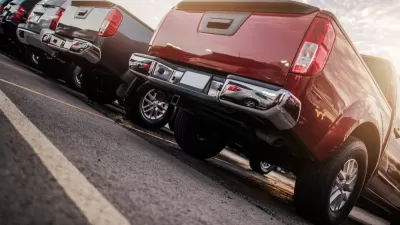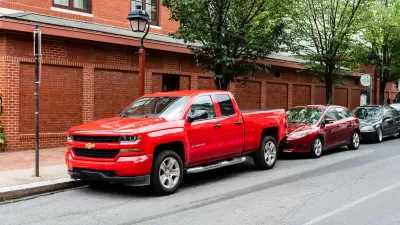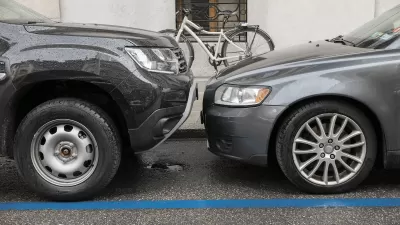Even with the growth of electric vehicles, experts say the trend toward larger, heavier vehicles is inherently incompatible with environmental goals.

Based on the amount of emissions they produced last year, the world’s SUVs are, collectively, the sixth largest emitter of carbon dioxide. Writing in The New Yorker, Elizabeth Kolbert points out that the average SUV releases 20 percent more carbon per mile driven than a medium-sized car.
“The move toward bigger and heavier vehicles, it seems pretty obvious, is incompatible with the goal of reducing global emissions.” So “Why is it that the world is moving toward heavier cars at a time when it should be doing precisely the reverse?”
One major reason, Kolbert writes, is the high price of SUVs, which are up to 51 percent more expensive than smaller cars, despite similar production costs. U.S. carmakers can also evade fuel efficiency standards by classifying vehicles as trucks. “Unfortunately, the electrical-vehicle tax credits approved last year as part of the Inflation Reduction Act give S.U.V.s similarly favorable treatment.”
In addition to carbon emissions, bigger vehicles also create more particulate pollution from tires and pose a higher risk to pedestrians. Experts suggest charging higher registration rates for heavier vehicles—a policy being considered in California—could discourage the proliferation of massive trucks and SUVs.
As Kolbert points out, replacing gas-powered cars with electric ones will only be a stopgap that reduces carbon emissions but creates other serious impacts on the environment and public safety. “Better still would be to ditch cars altogether.”
FULL STORY: Why S.U.V.s Are Still a Huge Environmental Problem

Alabama: Trump Terminates Settlements for Black Communities Harmed By Raw Sewage
Trump deemed the landmark civil rights agreement “illegal DEI and environmental justice policy.”

Planetizen Federal Action Tracker
A weekly monitor of how Trump’s orders and actions are impacting planners and planning in America.

Why Should We Subsidize Public Transportation?
Many public transit agencies face financial stress due to rising costs, declining fare revenue, and declining subsidies. Transit advocates must provide a strong business case for increasing public transit funding.

Understanding Road Diets
An explainer from Momentum highlights the advantages of reducing vehicle lanes in favor of more bike, transit, and pedestrian infrastructure.

New California Law Regulates Warehouse Pollution
A new law tightens building and emissions regulations for large distribution warehouses to mitigate air pollution and traffic in surrounding communities.

Phoenix Announces Opening Date for Light Rail Extension
The South Central extension will connect South Phoenix to downtown and other major hubs starting on June 7.
Urban Design for Planners 1: Software Tools
This six-course series explores essential urban design concepts using open source software and equips planners with the tools they need to participate fully in the urban design process.
Planning for Universal Design
Learn the tools for implementing Universal Design in planning regulations.
Caltrans
Smith Gee Studio
Institute for Housing and Urban Development Studies (IHS)
City of Grandview
Harvard GSD Executive Education
Toledo-Lucas County Plan Commissions
Salt Lake City
NYU Wagner Graduate School of Public Service





























